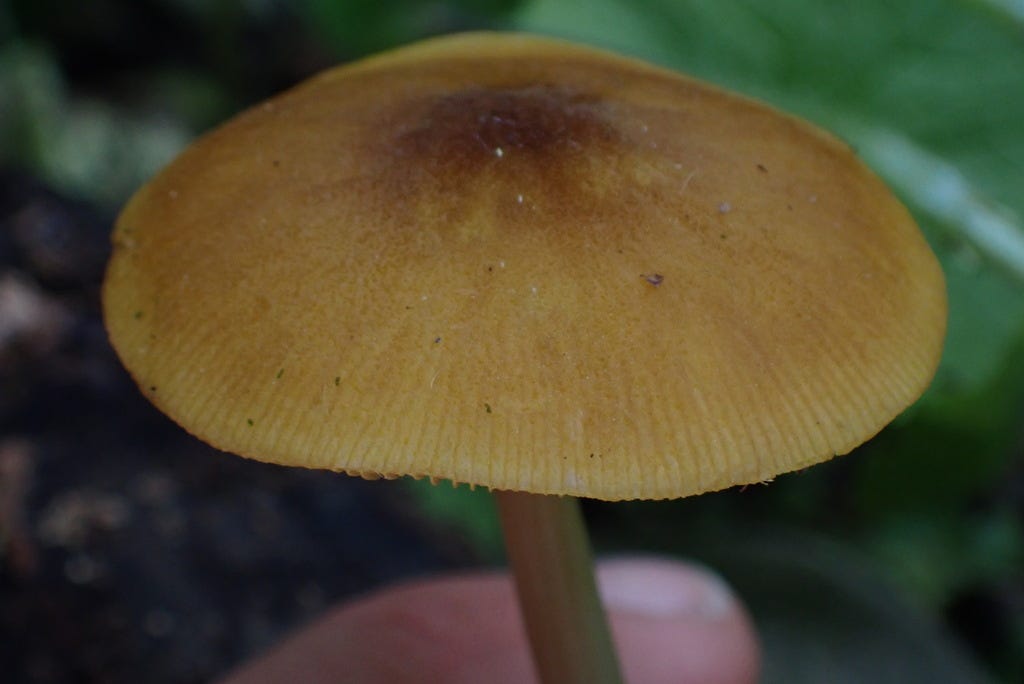Good evening, friends,
We wrapped up another great Friends of Fungi retreat with Catskill Fungi this past weekend. Each opportunity I get to participate in this wonderful weekend in the Catskills, I go in with the hope of finding a mushroom I’ve never seen before. This weekend our hopes came to fruition with the Lion Shield (Pluteus leoninus). Shield mushrooms (Pluteus) with their pink gills and brown caps are one of the quintessential spring mushrooms, but it’s not every year you find a yellow one.
Fun Facts
It’s unclear why mushrooms are colored. Some of the hypotheses as to why mushrooms produce certain pigments include to attract insects/animals to eat them and disperse their spores, warn others not to mess with them, but in a lot of instances it comes down to environmental conditions. The same species of fungus can have a different color from one locale to the next - modestly like from tan to brown, not from pink to green - based on moisture, sunlight, and other environmental factors.
Perhaps most interestingly, this study from Nature of 3.2 million European mushrooms suggests that mushrooms are darker in colder climates. The authors hypothesize that this is a thermal adaptation - mushrooms in colder climates want to be darker to attract sun and warm themselves. They also note that there is much more to mushroom coloration than thermal adaptation and we still have a lot to learn.
One thing I’ve noticed in high elevation, cold climates is that I feel like I see more long-lived mushrooms. Denser, hardier polypores that grow almost like wood, year after year, and just add a new pore layer each growing season. I saw a lot of these polypores when I was in the White Mountains and the Catskills, much more than I see at the preserve where I’m nearly sea level.

Ecology
The fungus is saprobic and digests dead hardwoods or organic material in the soil. You can find these mushrooms in the spring, but per iNaturalist they seem to appear more in the summer when observations peak in July and August. They can grow solitarily or in a cluster. The mushrooms can be found throughout temperate forests of the northern hemisphere, but the exact species of yellow Pluteus you find is not easy to decipher.

There is a very similar species, Pluteus chrysophlebius. The difference is in the size, and Pluteus leoninus is theoretically larger. Michael Kuo says on mushroomexpert.com that the cap of P. leoninus can range from 3-5 centimeters wide and the stipe can grow 5-9 cm long. The smaller, P. chrysophlebius, has a cap that ranges 1-2.5 centimeters long and a stipe that reaches 2-5 cm long. I measured our mushroom and they clocked in at 3 cm wide and 6 cm long, nothing conclusive but leans toward P. leoninus.
My gut says if you were to sequence these yellow Pluteus you would find that while these mushrooms look similar all over the world, genetically there is a very diverse population. In fact, this study already suggests that there is a species complex of yellow Pluteus. P. leoninus is technically a European species so I imagine some day we will know this mushroom by a different name.
Fungi in the News
If you didn’t see this, mushrooms got some nice pub this morning in the paper. Mandie Quark and Alan Rockefeller (who led our Ecuador foray earlier this spring), got a nice feature in the New York Times on their DNA sequencing efforts.
You can read the article here.
This Weekend
I’m hosting a free mushroom event at the Peekskill Regeneration Farm. We’re going to make some mushroom grow kits, have an ID table set up, try some shiitake log inoculation, and just kick it. Here’s more info, hope to see you there. Email me if you have any questions, too.
Today was the best weather I’ve gotten to experience in a while. A breezy 72 with a nice mix of sun and poofy clouds. Let’s have a great summer,
Aubrey
References:
Kuo, M. (2015, May). Pluteus leoninus. Retrieved from the MushroomExpert.Com Web site: http://www.mushroomexpert.com/pluteus_leoninus.html
Lezzi T, Vizzini A, Ercole E, Migliozzi V, Justo A. Phylogenetic and morphological comparison of Pluteus variabilicolor and P. castri (Basidiomycota, Agaricales). IMA Fungus. 2014 Dec;5(2):415-23. doi: 10.5598/imafungus.2014.05.02.06. Epub 2014 Nov 28. PMID: 25734031; PMCID: PMC4329323.
Krah FS, Büntgen U, Schaefer H, Müller J, Andrew C, Boddy L, Diez J, Egli S, Freckleton R, Gange AC, Halvorsen R, Heegaard E, Heideroth A, Heibl C, Heilmann-Clausen J, Høiland K, Kar R, Kauserud H, Kirk PM, Kuyper TW, Krisai-Greilhuber I, Norden J, Papastefanou P, Senn-Irlet B, Bässler C. European mushroom assemblages are darker in cold climates. Nat Commun. 2019 Jun 28;10(1):2890. doi: 10.1038/s41467-019-10767-z. PMID: 31253790; PMCID: PMC6599080.








